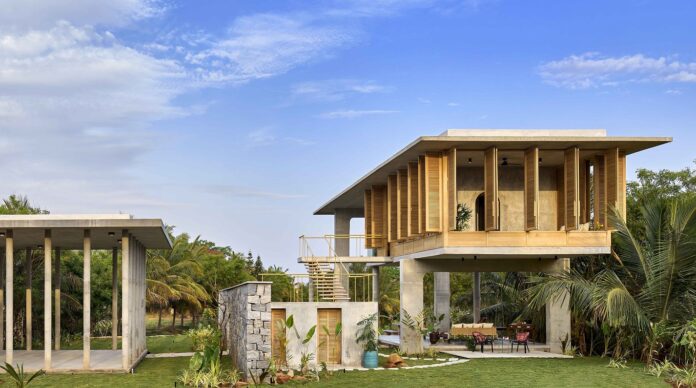
The worldwide pandemic that has hit every nation in the world and, finally, a new awareness and understanding of how our planet can be made more inhabitable in the future seem to me to be crucial in bringing about a turnaround in creative thinking in the realm of architecture.
How do we envisage the future appearance of the cities and “homes” that the world’s rapidly growing population will have to build or regenerate in the next century?
Choices increasingly focused on building and regenerating
Seemingly inevitable changes in the atmosphere, air pollution (also inevitable but not so soon) and the inadequate maintenance of what already exists, (not to mention all the monuments that need to be safeguarded), will force us to make choices increasingly focused on building and regenerating along industrial and materials-driven lines.
The laws of economics and labour may mean we have to build more macro-objects than proper constructions. Theese technologically cutting-edge designs that may look good but whose utility and superstructures are dictated more by marketing surveys than social needs.
Industrially similar designs may take precedence
My fear is that, if this happens, industrially similar designs may take precedence, buildings that are quite detached from the places and locations where communities choose to live. Ultimately, they may even ignore local cultures, myths and legends.
In a nutshell, we may have cities that are beautiful to look like ‘pleasure island’ but, as in the case of theme parks, they may be fun, but they will all look exactly the same.
Symbolic choices might help save the planet and mankind
Or alternatively, as we are documenting in this issue with the Ksarah project in India by Taliesyn architecture + Design, there is always the option of creating your own home as if it were an intangible, spiritual container. This kind of house, as well as meeting our needs in terms of physical comfort (the same for everybody), can also accommodate us in our own intellectual realm that protects without any inside or outside.
Choices of a symbolic and predominantly iconic nature, which, taken as the basis of design, might help save the planet and mankind through lots of small cities instead of metropolises, showing us that happiness can never be the realm of technology.
I am perfectly aware that this is utopian dreaming, but it is comforting just to think about it.
(a collaboration of L’Arca International, n.164, and Fyinpaper)
La casa come contenitore spirituale
La pandemia che ha coinvolto tutti i Paesi del mondo e finalmente la presa di coscienza e conoscenza globale di come il futuro possa rendere sempre più inabitabile il nostro pianeta mi sembra stiano determinando una cerniera importante nel pensiero creativo dell’architettura.
Come vediamo il futuro aspetto delle città, e delle “case” che l’umanità, sempre in crescita demografica, dovrà costruire o rigenerare nel prossimo secolo?
Scelte sempre più orientate a costruire e rigenerare
I mutamenti atmosferici (apparentemente inevitabili), l’inquinamento dell’aria (evitabile ma non presto), la scarsa manutenzione dell’esistente, senza contare i monumenti da preservare ci obbligheranno a scelte sempre più orientate a costruire e rigenerare perseguendo logiche legate al mondo industriale e materiale.
Le leggi dell’economia e del lavoro potranno costringerci a realizzare più dei macro-oggetti che delle costruzioni. Realizzazioni tecnologicamente evolute e anche esteticamente attraenti ma con utilità e sovrastrutture che possono essere determinate più dai sondaggi di marketing che da necessità sociali.
Format progettuali per la casa tutti industrialmente simili potrebbero prevalere
Il mio timore è che in questo caso possano prevalere molti format progettuali tutti industrialmente simili. Questi saranno però certamente slegati dai luoghi e dalle latitudini dove delle comunità scelgono di vivere. Il timore, anche, che vengano realizzati trascurando culture, miti e leggende.
Insomma, potremo avere città belle da vedere come la città dei balocchi ma, come avviene per i lunapark, tutte divertenti e simili.
La terra e l’umanità potrebbero salvarsi col contributo di scelte simboliche
Oppure, come documentiamo in questo numero con il progetto Ksaraah Weekend Home, esiste sempre la scelta di creare le proprie casa come un contenitore spirituale e immateriale. Essa, una volta assolte le nostre necessità di confort fisico – queste sì uguali per tutti – saprà ospitarci in una nostra sfera intellettuale che ci protegga senza un interno o un esterno.
Scelte anche simboliche e per lo più iconiche. Se adottate come base progettuale, potrebbero contribuire a salvare la Terra e l’umanità con molte piccole città e non metropoli. Constateremmo, così, che la felicità non potrà mai essere dominio della tecnologia.
So perfettamente che è un’utopia, ma dà sollievo pensarla.
(in collaborazione: l’Arca International, n. 164, e Fyinpaper)







